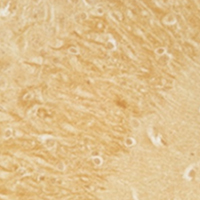Ion channels alterations in the forebrain of high-fat diet fed rats

Accepted: 27 October 2021
HTML: 21
All claims expressed in this article are solely those of the authors and do not necessarily represent those of their affiliated organizations, or those of the publisher, the editors and the reviewers. Any product that may be evaluated in this article or claim that may be made by its manufacturer is not guaranteed or endorsed by the publisher.
Authors
Evidence suggests that transient receptor potential (TRP) ion channels dysfunction significantly contributes to the physiopathology of metabolic and neurological disorders. Dysregulation in functions and expression in genes encoding the TRP channels cause several inherited diseases in humans (the so-called ‘TRP channelopathies’), which affect the cardiovascular, renal, skeletal, and nervous systems. This study aimed to evaluate the expression of ion channels in the forebrain of rats with diet-induced obesity (DIO). DIO rats were studied after 17 weeks under a hypercaloric diet (high-fat diet, HFD) and were compared to the control rats with a standard diet (CHOW). To determine the systemic effects of HFD exposure, we examined food intake, fat mass content, fasting glycemia, insulin levels, cholesterol, and triglycerides. qRT-PCR, Western blot, and immunochemistry analysis were performed in the frontal cortex (FC) and hippocampus (HIP). After 17 weeks of HFD, DIO rats increased their body weight significantly compared to the CHOW rats. In DIO rats, TRPC1 and TRPC6 were upregulated in the HIP, while they were downregulated in the FC. In the case of TRPM2 expression, instead was increased both in the HIP and in the FC. These could be related to the increase of proteins and nucleic acid oxidation. TRPV1 and TRPV2 gene expression showed no differences both in the FC and HIP. In general, qRT-PCR analyses were confirmed by Western blot analysis. Immunohistochemical procedures highlighted the expression of the channels in the cell body of neurons and axons, particularly for the TRPC1 and TRPC6. The alterations of TRP channel expression could be related to the activation of glial cells or the neurodegenerative process presented in the brain of the DIO rat highlighted with post synaptic protein (PSD 95) alterations. The availability of suitable animal models may be useful for studying possible pharmacological treatments to counter obesity-induced brain injury. The identified changes in DIO rats may represent the first insight to characterize the neuronal alterations occurring in obesity. Further investigations are necessary to characterize the role of TRP channels in the regulation of synaptic plasticity and obesity-related cognitive decline.
Ethics Approval
The protocol was approved by the Ethics Committee of the University of CamerinoSupporting Agencies
This research was supported by University of Camerino, Fondo d'Ateneo di Ricerca (FAR 2019).How to Cite

This work is licensed under a Creative Commons Attribution-NonCommercial 4.0 International License.
PAGEPress has chosen to apply the Creative Commons Attribution NonCommercial 4.0 International License (CC BY-NC 4.0) to all manuscripts to be published.
Similar Articles
- M. Scimeca, A. Pietroiusti, F. Milano, L. Anemona, A. Orlandi, L.T. Marsella, E. Bonanno, Elemental analysis of histological specimens: a method to unmask nano asbestos fibers , European Journal of Histochemistry: Vol. 60 No. 1 (2016)
- Flavia Carton, Laura Calderan, Manuela Malatesta, Incubation under fluid dynamic conditions markedly improves the structural preservation in vitro of explanted skeletal muscles , European Journal of Histochemistry: Vol. 61 No. 4 (2017)
- Monica Colitti, Federico Boschi, Tommaso Montanari, Dynamic of lipid droplets and gene expression in response to β-aminoisobutyric acid treatment on 3T3-L1 cells , European Journal of Histochemistry: Vol. 62 No. 4 (2018)
- Petra Rita Basso, Elena Carava', Marina Protasoni, Marcella Reguzzoni, Mario Raspanti, The synovial surface of the articular cartilage , European Journal of Histochemistry: Vol. 64 No. 3 (2020)
- Menghui Chen, Su Liu, Atorvastatin reduces calcification in valve interstitial cells via the NF-κB signalling pathway by promoting Atg5-mediated autophagy , European Journal of Histochemistry: Vol. 68 No. 2 (2024)
- T Cremer, C Cremer, Rise, fall and resurrection of chromosome territories: a historical perspective Part II. Fall and resurrection of chromosome territories during the 1950s to 1980s. Part III. Chromosome territories and the functional nuclear architecture: experiments and m , European Journal of Histochemistry: Vol. 50 No. 4 (2006)
- V Nicolin, P Narducci, C Celeghini, Effect of recombinant TRAIL in a murine co-culture system of osteoclastogenesis , European Journal of Histochemistry: Vol. 52 No. 1 (2008)
You may also start an advanced similarity search for this article.

 https://doi.org/10.4081/ejh.2021.3305
https://doi.org/10.4081/ejh.2021.3305










